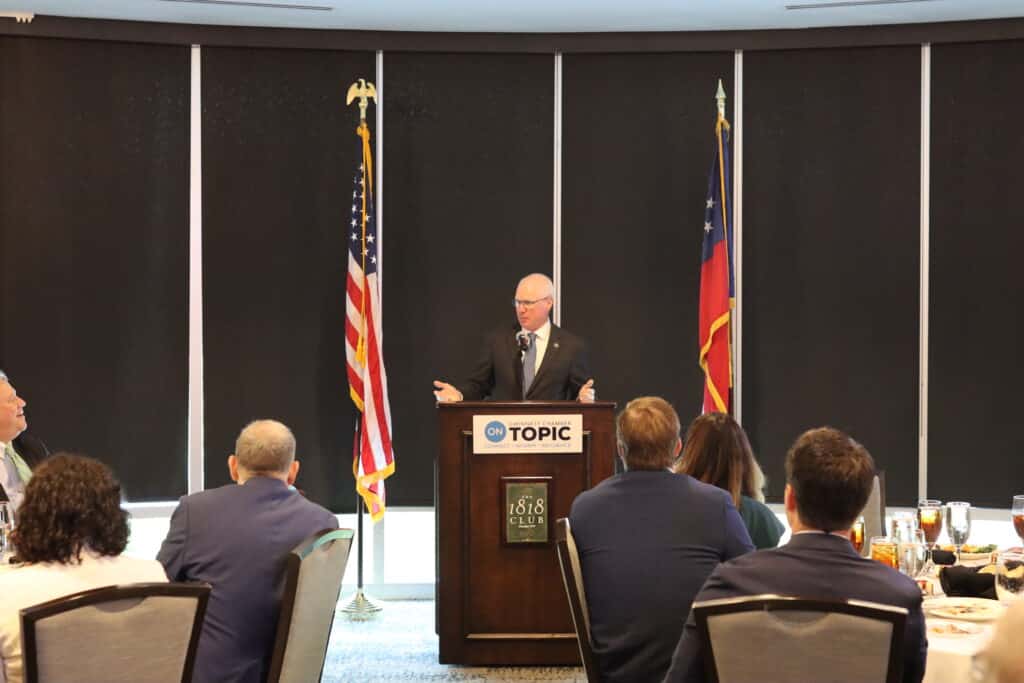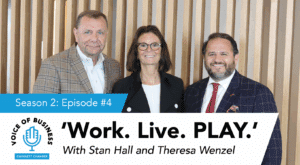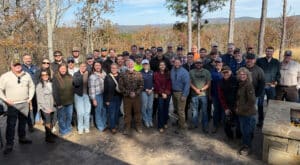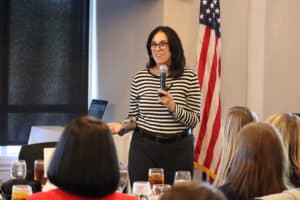If Gwinnett County’s roads and highways could talk, they’d tell the story of commerce, connection, and momentum. At the latest On Topic: Transportation Talk, presented by Porter Steel at the 1818 Club, Georgia DOT Commissioner Russell McMurry painted that story in bold strokes—how every intersection, lane, and interchange is a thread in our region’s economic fabric.
McMurry reminded the crowd that Georgia has now been ranked the best state in which to do business for 12 straight years. That designation doesn’t happen by accident; it’s built on infrastructure. “From moving freight and distribution vehicles to moving people and talent,” he said, “transportation is the backbone of growth.”
He walked through last year’s challenge: Hurricane Helene inflicted massive damage to Georgia’s system. Cleanup alone cost over $2 million, and crews removed roughly five million cubic yards of debris—that’s nearly the equivalent of three Empire State Buildings. In response, the state committed $250 million in formula funding to local governments—double the previous year—and Gwinnett received $12 million of that.
Then McMurry shifted to the forward motion: the megaprojects already in motion that will reshape Gwinnett’s mobility for decades. SR 316 is undergoing a dramatic reconstruction designed to improve safety and streamline traffic flow. Though the full stretch runs from Athens to Atlanta, many of the most complicated intersections are right here in Gwinnett. Among the highlights:
- Harbins Road got a boost through County SPLOST funding, proof that state and local investments work hand in hand.
- The 29/Winder Hwy Interchange will elevate Winder Road about 28 feet over 316 and add frontage roads to relieve pressure.
- Fence Road + Hurricane Trail connection, a 1.3-mile project with a $165 million price tag, will improve access across 316.
- The Hi-Hope Road Interchange, a $181 million overhaul now underway, will replace traffic lights with a full overpass and integrate multiple route options. Its completion is set for 2029.
“When you see an orange barrel,” McMurry said with a wry smile, “think progress.” But Gwinnett’s transformation isn’t limited to 316. Outside that corridor, dozens of projects are underway:
- A new I-85 / McGinnis Ferry Road interchange—$36 million—will help relieve congestion around Lawrenceville–Suwanee.
- SR 20 is being expanded to six lanes between Peachtree Industrial Blvd and SR 13 in a $38 million collaboration with Gwinnett and Buford. Completion set for Q2 2027.
- New turn lanes on Buford Highway aim to reduce backups near I-985.
- SR 211 is being widened in Braselton toward Friendship Road—$55 million—and the Governor has approved additional funds to expedite it.
- At Hamilton Mill, more turn lanes will ease flow near the I-85 / 124 interchange.
McMurry also highlighted the benefits Gwinnett draws from statewide projects—even when they don’t lie entirely within county lines. A public-private partnership is underway to build two express lanes along the GA-400 corridor—improving access to Atlanta and influencing traffic patterns that ripple out to Gwinnett. And along I-285’s northern arc, express lanes are being added on one of the nation’s most congested routes. “Our interstate system is eligible for Social Security,” McMurry joked, underscoring just how aged some stretches have become—and how much repair is needed.
Through it all, his message was clear: progress is not optional. These are not arbitrary improvements. Every dollar, every ramp, every lane is about connecting people and opportunity. Gwinnett’s business leaders and community voices have a role to play too. Infrastructure is not built in a vacuum; it’s built with alignment, advocacy, and shared goals.
Up next in the On Topic series: Raphael Bostic, President & CEO of the Federal Reserve Bank of Atlanta, will join us to share his perspectives on the economy, inflation, and the trends shaping our region’s future. Stay tuned, reserve your seat, and join the conversation at gwinnettchamber.org/on-topic.





